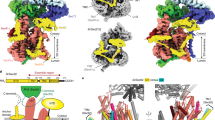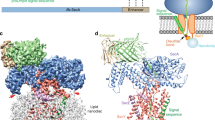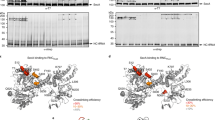Abstract
Many proteins are translocated through the SecY channel in bacteria and archaea and through the related Sec61 channel in eukaryotes1. The channel has an hourglass shape with a narrow constriction approximately halfway across the membrane, formed by a pore ring of amino acids2. While the cytoplasmic cavity of the channel is empty, the extracellular cavity is filled with a short helix called the plug2, which moves out of the way during protein translocation3,4. The mechanism by which the channel transports large polypeptides and yet prevents the passage of small molecules, such as ions or metabolites, has been controversial2,5,6,7,8. Here, we have addressed this issue in intact Escherichia coli cells by testing the permeation of small molecules through wild-type and mutant SecY channels, which are either in the resting state or contain a defined translocating polypeptide chain. We show that in the resting state, the channel is sealed by both the pore ring and the plug domain. During translocation, the pore ring forms a ‘gasket-like’ seal around the polypeptide chain, preventing the permeation of small molecules. The structural conservation of the channel in all organisms indicates that this may be a universal mechanism by which the membrane barrier is maintained during protein translocation.
This is a preview of subscription content, access via your institution
Access options
Subscribe to this journal
Receive 51 print issues and online access
$199.00 per year
only $3.90 per issue
Buy this article
- Purchase on Springer Link
- Instant access to full article PDF
Prices may be subject to local taxes which are calculated during checkout




Similar content being viewed by others
References
Rapoport, T. A. Protein translocation across the eukaryotic endoplasmic reticulum and bacterial plasma membranes. Nature 450, 663–669 (2007)
van den Berg, B. et al. X-ray structure of a protein-conducting channel. Nature 427, 36–44 (2004)
Harris, C. R. & Silhavy, T. J. Mapping an interface of SecY (PrlA) and SecE (PrlG) by using synthetic phenotypes and in vivo cross-linking. J. Bacteriol. 181, 3438–3444 (1999)
Tam, P. C., Maillard, A. P., Chan, K. K. & Duong, F. Investigating the SecY plug movement at the SecYEG translocation channel. EMBO J. 24, 3380–3388 (2005)
Hamman, B. D., Hendershot, L. M. & Johnson, A. E. BiP maintains the permeability barrier of the ER membrane by sealing the lumenal end of the translocon pore before and early in translocation. Cell 92, 747–758 (1998)
Liao, S., Lin, J., Do, H. & Johnson, A. E. Both lumenal and cytosolic gating of the aqueous ER translocon pore are regulated from inside the ribosome during membrane protein integration. Cell 90, 31–41 (1997)
Simon, S. M. & Blobel, G. A protein-conducting channel in the endoplasmic reticulum. Cell 65, 371–380 (1991)
Saparov, S. M. et al. Determining the conductance of the SecY protein translocation channel for small molecules. Mol. Cell 26, 501–509 (2007)
Li, W. et al. The plug domain of the SecY protein stabilizes the closed state of the translocation channel and maintains a membrane seal. Mol. Cell 26, 511–521 (2007)
Zhang, W., Bogdanov, M., Pi, J., Pittard, A. J. & Dowhan, W. Reversible topological organization within a polytopic membrane protein is governed by a change in membrane phospholipid composition. J. Biol. Chem. 278, 50128–50135 (2003)
Bieker, K. L., Phillips, G. J. & Silhavy, T. J. The sec and prl genes of Escherichia coli . J. Bioenerg. Biomembr. 22, 291–310 (1990)
Derman, A. I., Puziss, J. W., Bassford, P. J. & Beckwith, J. A signal sequence is not required for protein export in prlA mutants of Escherichia coli . EMBO J. 12, 879–888 (1993)
Smith, M. A., Clemons, W. M., Jr, DeMars, C. J. & Flower, A. M. Modeling the effects of prl mutations on the Escherichia coli SecY complex. J. Bacteriol. 187, 6454–6465 (2005)
Dalal, K. & Duong, F. The SecY complex forms a channel capable of ionic discrimination. EMBO Rep. 10, 762–768 (2009)
Schierle, C. F. et al. The DsbA signal sequence directs efficient, cotranslational export of passenger proteins to the Escherichia coli periplasm via the signal recognition particle pathway. J. Bacteriol. 185, 5706–5713 (2003)
Nakatogawa, H. & Ito, K. The ribosomal exit tunnel functions as a discriminating gate. Cell 108, 629–636 (2002)
Nakatogawa, H. & Ito, K. Secretion monitor, SecM, undergoes self-translation arrest in the cytosol. Mol. Cell 7, 185–192 (2001)
Woolhead, C. A., Johnson, A. E. & Bernstein, H. D. Translation arrest requires two-way communication between a nascent polypeptide and the ribosome. Mol. Cell 22, 587–598 (2006)
Ménétret, J. F. et al. Single copies of Sec61 and TRAP associate with a nontranslating mammalian ribosome. Structure 16, 1126–1137 (2008)
Becker, T. et al. Structure of monomeric yeast and mammalian Sec61 complexes interacting with the translating ribosome. Science 326, 1369–1373 (2009)
Schiebel, E. & Wickner, W. Preprotein translocation creates a halide anion permeability in the Escherichia coli plasma membrane. J. Biol. Chem. 267, 7505–7510 (1992)
Le Gall, S., Neuhof, A. & Rapoport, T. A. The endoplasmic reticulum membrane is permeable to small molecules. Mol. Biol. Cell 15, 447–455 (2004)
Heritage, D. & Wonderlin, W. F. Translocon pores in the endoplasmic reticulum are permeable to a neutral, polar molecule. J. Biol. Chem. 276, 22655–22662 (2001)
Roy, A. & Wonderlin, W. F. The permeability of the endoplasmic reticulum is dynamically coupled to protein synthesis. J. Biol. Chem. 278, 4397–4403 (2003)
Junne, T., Kocik, L. & Spiess, M. The hydrophobic core of the Sec61 translocon defines the hydrophobicity threshold for membrane integration. Mol. Biol. Cell 21, 1662–1670 (2010)
Wada, A., Yamazaki, Y., Fujita, N. & Ishihama, A. Structure and probable genetic location of a “ribosome modulation factor” associated with 100S ribosomes in stationary-phase Escherichia coli cells. Proc. Natl Acad. Sci. USA 87, 2657–2661 (1990)
Akiyama, Y. & Ito, K. SecY protein, a membrane-embedded secretion factor of E. coli, is cleaved by the OmpT protease in vitro. Biochem. Biophys. Res. Commun. 167, 711–715 (1990)
Baba, T. et al. Construction of Escherichia coli K-12 in-frame, single-gene knockout mutants: the Keio collection. Mol. Syst. Biol. 2, 2006.0008 (2006)
Datsenko, K. A. & Wanner, B. L. One-step inactivation of chromosomal genes in Escherichia coli K-12 using PCR products. Proc. Natl Acad. Sci. USA 97, 6640–6645 (2000)
Heller, K. B., Lin, E. C. & Wilson, T. H. Substrate specificity and transport properties of the glycerol facilitator of Escherichia coli . J. Bacteriol. 144, 274–278 (1980)
Acknowledgements
We thank P. Walter, H. Bernstein and G. Phillips for materials, D. Boyd for advice, C. Akey for discussions and C. Akey, A. Osborne and A. Salic for critical reading of the manuscript. The work was supported by a grant from the NIH (GM052586). T.A.R. is a Howard Hughes Medical Institute investigator.
Author information
Authors and Affiliations
Contributions
E.P. performed the experiments and E.P. and T.A.R. wrote the manuscript.
Corresponding author
Ethics declarations
Competing interests
The authors declare no competing financial interests.
Supplementary information
Supplementary Information
This file contains Supplementary Figures 1-16 with legends, Supplementary Tables 1-2, a Supplementary Discussion and additional references. (PDF 5591 kb)
Rights and permissions
About this article
Cite this article
Park, E., Rapoport, T. Preserving the membrane barrier for small molecules during bacterial protein translocation. Nature 473, 239–242 (2011). https://doi.org/10.1038/nature10014
Received:
Accepted:
Published:
Issue Date:
DOI: https://doi.org/10.1038/nature10014
This article is cited by
-
Control of membrane barrier during bacterial type-III protein secretion
Nature Communications (2021)
-
Structure of the substrate-engaged SecA-SecY protein translocation machine
Nature Communications (2019)
-
The interaction network of the YidC insertase with the SecYEG translocon, SRP and the SRP receptor FtsY
Scientific Reports (2018)
-
Protein export through the bacterial Sec pathway
Nature Reviews Microbiology (2017)
-
Structure of the quaternary complex between SRP, SR, and translocon bound to the translating ribosome
Nature Communications (2017)
Comments
By submitting a comment you agree to abide by our Terms and Community Guidelines. If you find something abusive or that does not comply with our terms or guidelines please flag it as inappropriate.



